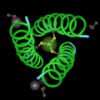Like many people I know, I suffer from allergies, and sometimes asthma. I take drugs to control the symptoms, but they don't cure the condition. Plus, I know there can be side effects that might not be so pleasant.
This is why I like hearing about sequencing projects that target the VDJ-ome.
I have this fantasy about the things we could do with that information
In a normal immune response (diagrammed below), antibodies on the surface of immature B cells bind to allergens (pollen, dust, whatever). That binding event, plus some help from T cells, stimulates those immature B cells and causes them to grow.
Some of those stimulated B cells become memory cells. They hang around, in case the allergen reappears. Other B cells go on to become plasma cells. They produce and secret antibodies.
In the case of allergies, those antibodies are IgE. IgE binds to the surface of basophils and mast cells. When IgE binds allergens, those cells release cytokines that do lots of nasty things including making your eyes red and your nose run.

Note: This diagram only shows some of the things that happen in an immune response.
In my fantasy, we use the sequence of the rearranged VDJ region to find and kill those B cells before they can cause me problems. Oh, yeah and the memory B cells too!

That's why I've always liked the drug omalizumab (Xolair). It's an anti-IgE antibody, so it ends up blocking the little buggers before they end up triggering the cascade.
Unfortunately, it's still frightfully expensive and needs to be administered via injection (though, I think I saw a study that got some results with a nasal spray).
Thanks Gary, that's really interesting. I'm not keen on injections, if the antibodies work, but I'd rather have a shot than the symptoms.
As far as expense, I'm currently taking drugs that I may be taking continuously all my life. I'd be interested to know how an occasional expense for Xolair compares to life time expenses for Singulair ® and Clarinex ®.
Xolair is somewhere around $1000/month right now. Really only for people that have life threatening asthma or allergies.
I suspect that something will come down the line in the next 5-10 years to fix allergies - and hopefully a number of other autoimmune disorders. If nothing else, Xolair will go off patent and we'll see a price drop.
One other area of research which looks somewhat promising is 'rush immunotherapy'. Basically, it's like normal allergy shots, but rather than starting with small doses, they give you immunosuppressant drugs and then large doses of the allergen. Some studies are showing some very promising results in this area.
Note: Clarinex is really a waste of money. You'll notice that it has exactly half the dosage of Claritin. Basically, Claritin was released with both stereoisomers in the drug. Clarinex just has the non-useful one filtered out and they released it when Claritin went off patent.
Thanks Gary,
That's a bit different than what I was told. I was told that Clarinex lasts longer is more effective than Claritin. I guess I have some more research to do.
I also realized, after thinking about this, that there could be some problems with taking a drug that's an antibody to IgE. Wouldn't you develop antibodies to the drug? Wouldn't that cause a condition like serum sickness?
Wouldn't you develop antibodies to the drug?Yes, eventually this can become a problem, but usually takes some time to develop, and doesn't develop in everyone. Sometimes this issue can be mitigated (a little) by formulation changes.
Actually your model is a wee bit outdated, by about, hmm, 3-4 years. We don't mess with VDJ recombinations because you really need those for generating new immune responses to previously-unencountered bugs. A better strategy is to figure out why a particular subset of T cells, the Tregs, aren't working properly for you. The function of the Treg is to tell the other lymphocytes to keep it down, stop making all that racket.
What would be nice is an iterative model of the immune system to include action of cytokines, epitope homologies, VDJ recombination and so forth, and also everything we know about hematopoeisis. Mostly there are in silico models of the individual parts, but never the whole thing together. You need to have the iteration bit in there because your immune system really does sort of percolate constantly.
Thanks Lora,
If I'm only 3-4 years behind, I'm pretty happy. It's been about 7 years since I last taught immunology.
I wasn't thinking about stopping VDJ recombination though, I was thinking we could kill the cells that had encountered allergens and undergone clonal expansion.
Just a bit of wishful thinking, I guess.
Are you familiar with the Pollinex Quattro vaccines? Those trials might be worth keeping an eye on, if pollens are one of your triggers. (Believe me, I am.)
Provided as a starting point:
http://www.fiercebiotech.com/press-releases/pivotal-phase-iii-pollinex-…
Thanks Luna,
Pollen is one trigger. Upper respiratory viral infections are another.
I'll keep an eye this, it sounds interesting.